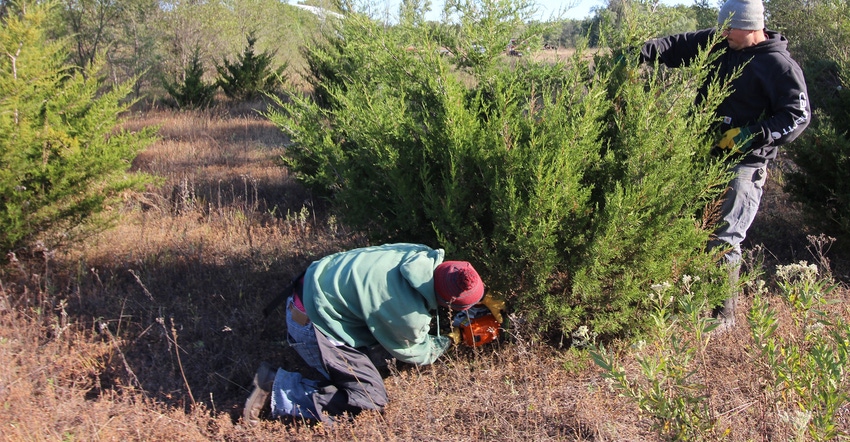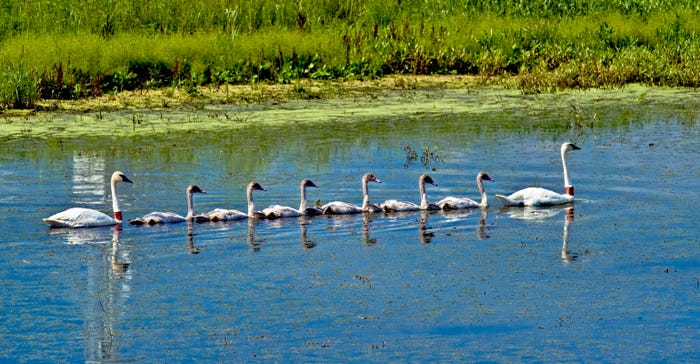February 21, 2020

About 15 volunteers gathered on a Saturday morning last fall to clear invasive sumac and eastern red cedar from a small sand prairie remnant on the Muscatine Island Research Farm near Fruitland in southeast Iowa. Persisting along a railroad track, the sand prairie sits amid Iowa State University’s research and demonstration irrigated fields for melons, vegetable crops and soybeans.
The preserved sand prairie has plants you wouldn’t expect to find in Iowa, like eastern prickly pear (Opuntia humifusa) and porcupine grass (Stipa spartea), says Dominic Snyder, co-manager of the research farm owned by the Muscatine Island Research Farm Association. He sees the prairie as a “rich learning tool that can help connect visitors to the farm’s past, as well as its future.”
Snyder teamed up with ISU faculty, staff and students, local volunteers and members of the farm board for the cleanup. Future plans for the prairie include interpretive signage and a field day on pollinator education with a beekeeper who has hives nearby.
Wild portfolio showcased
The Fruitland farm is one of the research and demonstration farms across the state in ISU’s portfolio. Activities on the farms are based on local soil types, landforms, and the needs and interests of local farmers and communities. Some have been donated and are owned by the university. Many, like the Muscatine Island farm, are owned by affiliate groups operating in cooperation with the Iowa Agriculture and Home Economics Experiment Station.
“In addition to showcasing agricultural science and practice, our research farms reflect a long history of conservation leadership that dates back to the earliest days of the Iowa State Agriculture College founded in 1858,” says Mark Honeyman, associate dean of operations for the College of Agriculture and Life Sciences, who has directed ISU’s Research and Demonstration Farms since 1983.
Among the farms’ productive acres are many gems of conservation. Prairies, wetlands, forests, jackrabbits, barn owls and bobcats are part of ISU research farms, often found next to crop research plots and advanced facilities to study livestock, robotics and plant breeding. The diversity provides opportunities for faculty and graduate students to learn about the state’s natural heritage and to research topics of interest for tomorrow’s resilient agriculture, such as soil health, carbon sequestration and nutrient flux.
Conservation can be complementary
The Kelly Research Farm northwest of Ames, also known as the swine nutrition farm, has a large prairie pothole wetland where Adam Janke, assistant professor of natural resource ecology and management, often takes students. They study wetland ecology, test protocols for aquatic insect sampling and use drones to locate and study waterfowl and pheasants. Recently, he says, they made an exciting find there: a brood of trumpeter swans hatched from a nest perched on a muskrat hut.
Janke, the Extension wildlife specialist and state leader for the Master Conservationists Extension Program, agrees that ISU’s research farms are an important resource for students — and Iowans.
“One of my goals is to help make ISU farms an even better model to show our students and neighbors how wildlife and productive agriculture can co-exist and even be complementary,” Janke says. As an example, he references new research and farming technologies that show landowners where they might take low-profit areas off the farm balance sheet and consider other options, like putting the land into conservation programs.
“ISU research farms can play an important role in helping ag students prepare to integrate land stewardship into land management, to show that it can be good for farming, for people downstream and for future generations.”
On-the-ground conservation
The Armstrong Memorial Research Farm near Lewis in southwest Iowa has been a showcase for such ideas. Owned by the Wallace Foundation for Rural Research and Development, the farm has rolling landscape features, long slopes and windblown, loess soils prone to erosion.
Corn and soybeans are a primary focus, along with pasture and hay, since local farmers still tend to have livestock. The farm also boasts one of the state’s best demonstrations of prairie strips. Its “sister,” Neely-Kinyon Farm, nearby at Greenfield claims one of the country’s largest and oldest set of organic research plots.
The farm has always included grassed waterways, field borders and pastures, according to Shawn Shouse, an ISU Extension ag engineering specialist who works at the farm. He says he has found it especially rewarding through the years to work on conservation projects with faculty and students.

WETLANDS & WILDLIFE: A pair of trumpeter swans with their brood on the wetland at ISU’s Kelly Research Farm near Ames.

One summer intern helped him design a grass waterway outlet to stop gullying from cutting into a field and road ditch. “The waterway has been a perfect example to show at field days since that type of erosion is often a challenge for area farmers,” he says.
Recently, he hosted a session of the Master Conservationist Program from West Pottawattamie County Extension. The class used the farm to learn about watersheds and see how the farm uses practices such as cover crops, buffer strips, conservation tillage and perennial crops in rotation to incorporate soil and nutrient management into its working lands. “It was a great learning experience for all involved,” Shouse says, “including for me.”
Cutting-edge conservation
The Uthe Farm south of Ames, owned by the ISU affiliate organization, the Committee for Agricultural Development, is another popular site for watershed tours. Its long slopes along Big Creek and large upland flat areas encompass corn and soybean fields, a switchgrass variety trial and field borders with game bird habitat. Buffer strips protect the creek flowing into the popular lake at Big Creek State Park.
ISU students have conducted bird surveys that show the farm is used by a diversity of breeding birds, including bobolinks, upland sandpipers and sedge wrens, all species in decline over much of their range. Visitors can visit cutting-edge conservation technologies, including a bioreactor, a saturated riparian buffer and an oxbow restoration, all monitored to assess performance over time.
“The Uthe Farm has been a great model to show the cohabitation of intensive agriculture and intensive conservation,” says Ethan Thies, an agricultural specialist there for several years. Thies, who is wrapping up a master’s in ag education at ISU, recently left to take a position as Black Hawk Lake Watershed Coordinator for the Sac County Soil and Water Conservation District.
“I’ve seen a lot of interest from all kinds of people who have come to Uthe to see conservation practices on the ground,” Thies says. “Adult learners want to experience things in person rather than just hearing about them.
“I think a public university like Iowa State has a responsibility to set the example,” he says. “Our research farms are — and should be — places where people can come and see the latest research and also have the idea reinforced that conservation is an important part of modern agricultural management.”
Robinson is the science writer for Iowa State University College of Agriculture and Life Sciences.
Source: ISU, which is solely responsible for the information provided and is wholly owned by the source. Informa Business Media and all its subsidiaries are not responsible for any of the content contained in this information asset.
You May Also Like




